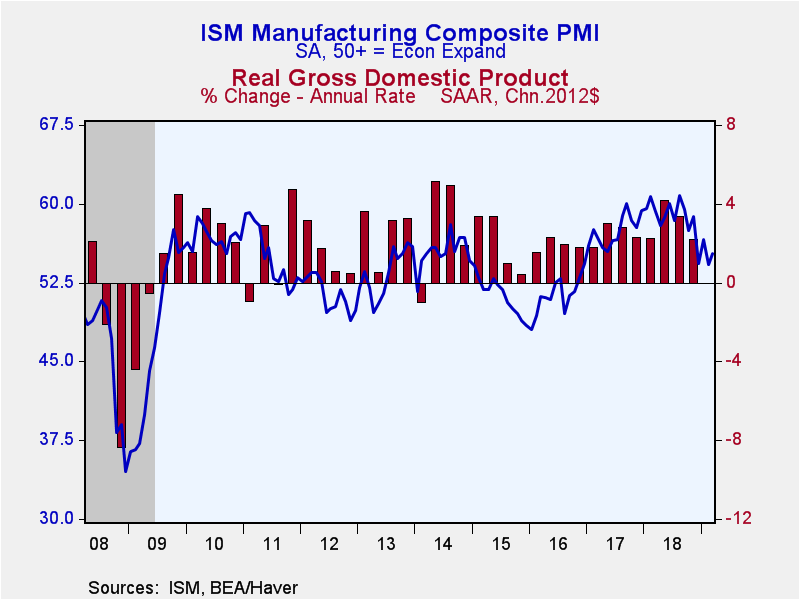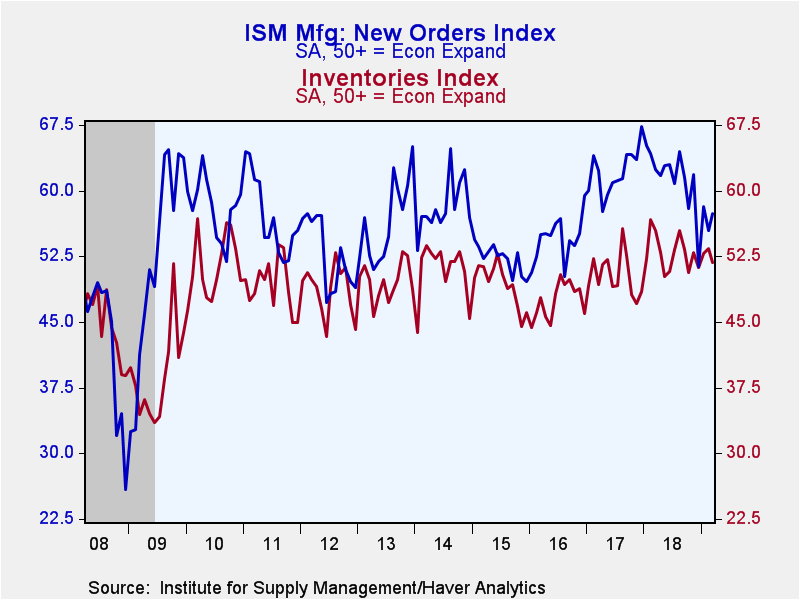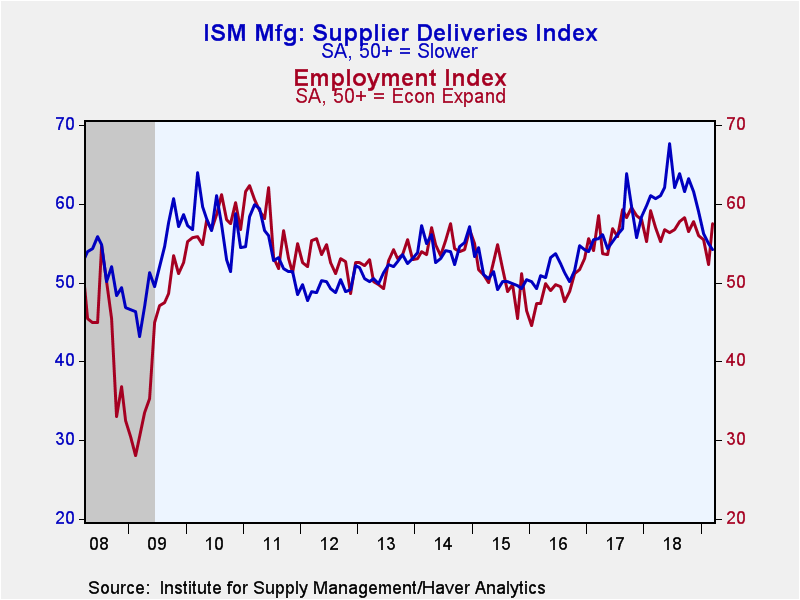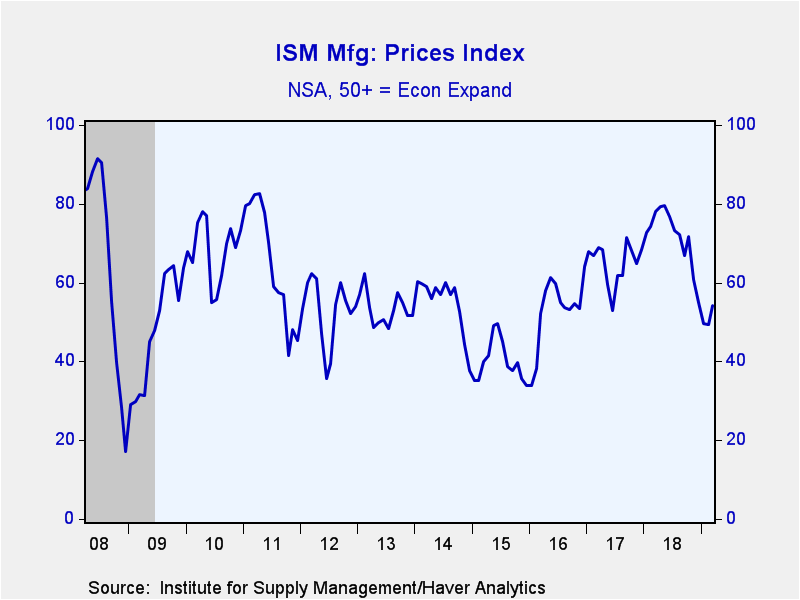 Global| Apr 01 2019
Global| Apr 01 2019ISM Manufacturing Index Improves, But Not by Much
by:Tom Moeller
|in:Economy in Brief
Summary
The ISM manufacturing index unexpectedly rose to 55.3 in March from 54.2 in February, but remained close to its weakest level since late-2016. The index remained below its expansion peak 60.8 last August. The Action Economics Forecast [...]
The ISM manufacturing index unexpectedly rose to 55.3 in March from 54.2 in February, but remained close to its weakest level since late-2016. The index remained below its expansion peak 60.8 last August. The Action Economics Forecast Survey anticipated an improvement to 54.6. Since 2008, there has been a 73% correlation between the index level and the quarter-to-quarter growth in real GDP.
Movement amongst the component series was mixed last month. The new orders index increased to 57.4 and made up most of its February decline. The production index improved to 55.8, but remained well below the January 2018 high. Working lower was the inventories index which fell to 51.8, and was well below the expansion high reached last March. The supplier deliveries continued its recently sharp decline, and fell to 54.2. That suggested the quickest product delivery speeds since mid-2017.
The employment measure recovered to 57.5 from the two-year low of 52.3. A sharply increased 25% of respondents reported more hiring while 12% reported fewer jobs.
The separate new export index eased to 51.7, its lowest level since October 2017. The imports index fell to a roughly two-year low. The order backlog measure also declined modestly and remained well below its May 2018 high.
The prices paid index increased to 54.3 (NSA) in March, but remained well below the high of 79.5 last May. A greatly lessened 19% of respondents reported paying higher prices, the smallest percentage in three years, while 11% paid less.
The ISM figures are diffusion indexes where a reading above 50 indicates expansion. The figures from the Institute for Supply Management can be found in Haver's USECON database; further detail is found in the SURVEYS database. Commodity prices can be found in USECON as well as the CMDTY database. The expectations number is available in Haver's AS1REPNA database.
| ISM Mfg (SA) | Mar | Feb | Jan | Mar'18 | 2018 | 2017 | 2016 |
|---|---|---|---|---|---|---|---|
| Headline Index | 55.3 | 54.2 | 56.6 | 59.3 | 58.8 | 57.4 | 51.3 |
| New Orders | 57.4 | 55.5 | 58.2 | 62.4 | 61.5 | 62.2 | 54.5 |
| Production | 55.8 | 54.8 | 60.5 | 61.2 | 60.7 | 60.9 | 53.8 |
| Employment | 57.5 | 52.3 | 55.5 | 57.0 | 56.9 | 56.8 | 49.1 |
| Supplier Deliveries | 54.2 | 54.9 | 56.2 | 60.7 | 62.0 | 56.8 | 51.8 |
| Inventories | 51.8 | 53.4 | 52.8 | 55.5 | 52.9 | 50.4 | 47.5 |
| Prices Paid Index (NSA) | 54.3 | 49.4 | 49.6 | 78.1 | 71.7 | 65.0 | 53.1 |
Tom Moeller
AuthorMore in Author Profile »Prior to joining Haver Analytics in 2000, Mr. Moeller worked as the Economist at Chancellor Capital Management from 1985 to 1999. There, he developed comprehensive economic forecasts and interpreted economic data for equity and fixed income portfolio managers. Also at Chancellor, Mr. Moeller worked as an equity analyst and was responsible for researching and rating companies in the economically sensitive automobile and housing industries for investment in Chancellor’s equity portfolio. Prior to joining Chancellor, Mr. Moeller was an Economist at Citibank from 1979 to 1984. He also analyzed pricing behavior in the metals industry for the Council on Wage and Price Stability in Washington, D.C. In 1999, Mr. Moeller received the award for most accurate forecast from the Forecasters' Club of New York. From 1990 to 1992 he was President of the New York Association for Business Economists. Mr. Moeller earned an M.B.A. in Finance from Fordham University, where he graduated in 1987. He holds a Bachelor of Arts in Economics from George Washington University.










